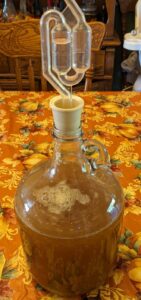In yesterday’s post I mentioned the prospect of fighting a losing war against Skynet, hoping for the reward of a frothy mug of mead in Valhalla. My friend Allan asked where to get a frothy mug of mead on the living side of things. To explain that I’ll have to give a quick lesson on fermentation.
Fermentation is what happens when yeast converts sugars to alcohol and carbon dioxide. You can ferment any sugary liquid. Grape juice becomes wine. Diluted honey becomes mead. The sweet liquid you get from mashing barley malt becomes beer (after adding hops). And just for fun I’ve fermented other things, like cranberry juice, prune juice, etc.
As the liquid ferments, CO2 is released. This creates a bubbly, frothy, and foamy mess.
In homebrewing, you typically allow this process to go the whole way. You let the yeast ferment all the sugar it can until the fermentation stops. If you want a still beverage, like wine, you leave it that way. If you want a carbonated beverage, like beer, you either pump in CO2, or you add a little more sugar and seal it off in a closed container — like a bottle or a keg. The yeast does a second fermentation in the bottle, creating just enough CO2 to carbonate the beer. (If you’re careful. If you’re not, your bottles explode.)
Mead is a little strange because you can make it carbonated or still, dry or sweet. Most of the meads you buy at the store are still. That is, uncarbonated. Charm City Meadworks makes some carbonated meads, and of course I have brewed one. Or … several.
Vikings didn’t have bottles or air-tight kegs, so they had no way to carbonate things the way we do. They most likely drank the mead while it was still fermenting. That is, while the open vat of mead was still bubbling and frothing from the fermentation. (They didn’t know about yeast, but there’s natural yeast in the air all around us.)
If you want a frothy mug of mead, you’re probably going to have to make it yourself — and drink it while it’s still fermenting. Here are some step-by-step instructions.

- Get a 1-gallon glass jug, like the kind they sell cider in.
- Either buy some sanitizing solution, or use 1 tablespoon of bleach to a gallon of water to make an easy sanitizer.
- Clean and sanitize your jug, then rinse it clean.
- Add 3 pounds of honey.
- Add the juice of a small lemon and a strong cup of black tea.
- If you have it, add a teaspoon of yeast nutrient.
- Add a packet of wine yeast (Yes, you can use regular yeast if you want to be cheap.)
- Fill it almost to the top with water and shake it all up to mix.
- Fit your gallon jug with a stopper and an air lock. (Once again, if you want to be cheap, just cover it with a paper towwel and attach it with a rubber band. But that might make more mess than you want.)
This is a very simple recipe, and experienced brewers might recommend heating the water and honey first (to almost boiling), using a different yeast, or … Whatever. It gets complicated. This recipe/method will get you there.
In about three days your mead should be fermenting like crazy. Pour a glass and see what you think. What you’ll get is probably something generally similar to what the Vikings had in their feasts.
You can also wait until the fermentation is finished and try a still version.
If you decide to give this a try, let me know how it goes. And if you want to learn more about brewing, try my book.

